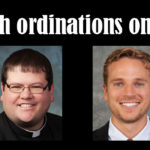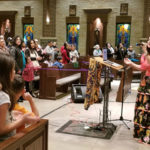By Ella Johnson
When I was a child, the sacrament of anointing of the sick was the scariest one of them all. Honestly, it brought images to my mind of the Grim Reaper. The priest, dressed in black, anointing someone at their bedside, seemed to me to be a harbinger of death. He was just going to give them some comfort, I thought, in the face of imminent death.
Although my childhood imagination wasn’t aware of it, I perceived something associated with the sacramental theology of extreme unction. This theology developed from the ritual’s almost exclusive focus on the dying, which occurred for more than 900 years in Church history, that is, from the 11th century until the liturgical reforms of the Second Vatican Council in the mid-1960s.

In the first completed document of Vatican II, Sacrosanctum Concilium (the Constitution on the Sacred Liturgy), the council fathers moved that “Extreme Unction” be more fittingly called “Anointing of the Sick,” “since it is not a sacrament for those only who are at the point of death” (#73). They were recovering the theological roots of the sacrament, which were associated with sickness and suffering in all its forms — spiritual, mental and physical — and not just leading to death.
This broader understanding of the sacrament as anointing of the sick includes more symbols —symbols beyond imminent death. For example, the primary symbol is now anointing and the symbol of anointing is primarily a symbol of embrace. Theologian Peter Fink has commented on this symbol, reminding us of the parable of the Good Samaritan in which the one who “while traveling came near him (the robbed and beaten victim); and when he saw him, he was moved with pity. He went to him and bandaged his wounds, having poured oil and wine on them. Then he put him on his own animal, brought him to an inn, and took care of him” (Luke 10:33-34). The traveler embraced the ill and suffering person out of love.
The symbol of embrace may also be seen in how the oils used in anointing cause us to recall the oils used in our baptism and confirmation, in which a person is initiated into the Church community. In the sacrament of anointing, the Church is called to embrace this initiated person, now ill or suffering, in a different way: by tending to their needs, both spiritual and physical. Like the Good Samaritan, if we are healthy and passing by someone sick, we are called to act out of love, offering whatever care and comfort we can.
This symbol of embrace, then, is a symbol for both the sick and the healthy. Indeed, Sacrosanctum Concilium #26 clearly states all “liturgical services pertain to the whole body of the Church.” In this sacrament, all members of the Church have something to learn from witnessing the sick being anointed. We are reminded to take care of one another in works of charity and service. However, we are also reminded of the mortality and finitude we all share.
Thinking about sickness, aging and death is uncomfortable — and we do nearly everything in our society to keep the troubling image out of view. For instance, we have homes and institutions that relegate the ill and elder members of our society to separate places. However, this sacrament, if we are paying attention to it, pushes us in the other direction.
By holding up illness for all to see, it asks everyone to remember our vulnerability and mortality. It challenges those of us who place our self-worth in productivity and achievement to remember the necessity of rest. It subverts the ideals underlying our technological and consumerist Western society in which security and comfort are founded in health. It speaks a reminder and a prophetic word of justice, calling us to turn to the marginalized. It reminds us all to join our sufferings to those of Christ, who offers hope in the resurrection.
Moving away from my childhood association of the sacrament with the Grim Reaper clearly has its advantages! I’ve also come to realize that imminent death is not the only thing to be afraid of. As an adult, I’ve now experienced serious sickness myself and witnessed loved ones experience sickness, too. I know that sickness often entails physical separation from loved ones (e.g., COVID-19 quarantine/isolation protocols); a fragmentation of mind, body and soul (e.g., dementia); and often a change in role status (e.g., from caregiving to care receiving). Sometimes these changes are temporary, when people recover, and sometimes they are not, when people become chronically ill or disabled.
This liminality is scary and uncomfortable. However, when embraced it can remind us of the liminality that characterizes us all, who are in-between life and death, working for the “not yet” kingdom of God to be established “already” on earth.
(Ella Johnson is an associate professor in the St. Ambrose University Theology Department in Davenport.)











